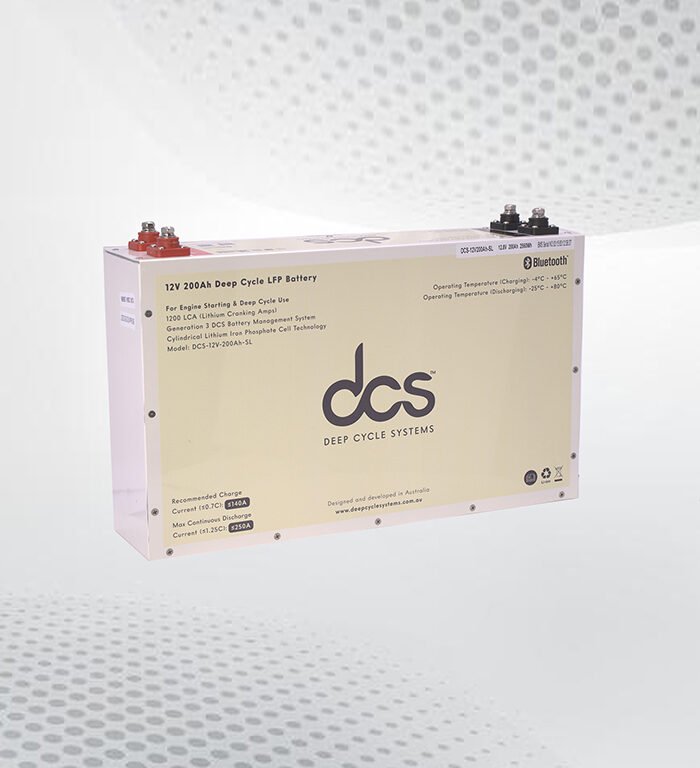Ultimate Guide to Understanding 200 Amp Hr Battery

The importance of a reliable and efficient battery cannot be overstated when it comes to powering various devices and vehicles. One such battery that has gained popularity recently is the 200 Amp Hr Battery. This powerful battery is known for its ability to provide long-lasting energy and high performance, making it a popular choice for a wide range of applications. In this blog post, we will delve into the efficacy of a battery, exploring its basics, versatility, longevity, environmental impact, cost analysis, and more.
The Basics of a 200-amp Battery
A 200-amp-hr battery, also called a 200-amp-hour battery, is a significant development in rechargeable battery technology, capable of dispensing 200 amp-hours of electrical energy. This delineates its capacity to sustain a current of 200 amps over one hour or to emit a lower current spanning a more extended duration. Such batteries find extensive usage across many energy-intensive domains, including electric vehicles, solar power installations, and marine applications.
The foundation of its utility lies in its remarkable ability to store and deliver a substantial volume of energy, catering to the demands of various high-power requisites. These batteries are characterised by their deep cycle nature, designed to be depleted and recharged numerous times, showcasing resilience and consistency in performance across their lifespan. The composition of a 200-amp-hr battery, encompassing advanced materials and technology, ensures it meets the rigorous demands of the applications it powers, affirming its status as a cornerstone of contemporary energy solutions.
The Versatility of the 200 Amp Hour Battery
The 200 Amp Hour Battery boasts exceptional versatility, making it an asset in a diverse array of applications. Its capacity to deliver high currents renders it indispensable in scenarios demanding significant power, whilst its rechargeable nature contributes to its repeated usability without diminishing its efficiency. This variety of usage spans from operating compact electronic apparatus to providing auxiliary power for residential and commercial establishments.
This adaptability is further underscored by its suitability for use in electric vehicles, where the demand for a consistent and robust energy supply is paramount. Additionally, integrating such batteries into renewable energy systems exemplifies their role in facilitating sustainable power solutions. The broad utility of the 200-amp-hr battery across various sectors underlines its significance in contemporary energy management and application strategies, embodying a versatile solution to modern power challenges.
Comparing Battery Technologies
In energy storage, various battery technologies vie for supremacy, each boasting distinct features and advantages. The 200-amp-hr battery, whilst lauded for its robust capacity and efficiency, forms part of a broader spectrum of options, including lithium-ion, lead-acid, and nickel-metal hydride batteries. Lithium-ion batteries are celebrated for their high energy density and lightweight characteristics, especially suited for portable electronics and electric vehicles.
On the other hand, lead-acid batteries are known for their affordability and reliability, though they typically carry a heavier weight and offer lower energy density. Nickel-metal hydride batteries emerge as a middle ground, offering a balance between cost and performance, with a notable advantage in terms of environmental friendliness compared to lead-acid variants.
Each technology carries implications for environmental impact, maintenance needs, and lifecycle costs, making the selection of the appropriate battery a critical consideration in the design and implementation of energy solutions. This comparative analysis underscores the necessity of matching battery attributes with specific application demands to harness optimal performance and sustainability.
The Longevity and Maintenance of a 200-amp-hr Battery
The longevity and maintenance of a 200-amp-hr battery are paramount considerations in energy storage solutions. Renowned for its extended lifespan, this battery can serve efficiently for several years, assuming it receives the appropriate care. The essence of prolonging the operational life of a 200-amp-hr battery lies in adhering to regular charging protocols and performing routine maintenance checks. These practices are instrumental in safeguarding against battery performance degradation over time.
Owners must observe the manufacturer’s guidelines for charging cycles and maintenance routines, as this can significantly mitigate the risk of premature battery failure. Moreover, understanding the environmental conditions that may affect battery longevity is vital. Factors such as temperature extremes, humidity, and prolonged inactivity can adversely impact the battery’s health. Implementing preventative measures to shield the battery from such conditions is therefore advisable.
Additionally, using advanced charging technologies that prevent overcharging and deep discharging can further enhance the lifespan of a 200-amp-hr battery. While the robustness of these batteries is well documented, their enduring efficiency is contingent upon a proactive approach to maintenance and care, ensuring that they continue to meet the energy demands placed upon them without faltering.
The Environmental Impact of Using a 200-amp-hour Battery
In an era where environmental sustainability has become a crucial factor in evaluating technological advancements, deploying 200-amp-hour batteries presents a notable advantage in reducing ecological footprints. By their efficiency and extended service life, these batteries contribute significantly to decreasing the frequency of battery replacements, thereby mitigating the waste associated with discarded units. Further, the materials and manufacturing processes of 200-amp-hour batteries have been refined to minimise harmful emissions, aligning with global efforts to combat environmental degradation.
The recyclability of these batteries also plays a pivotal role in fostering a circular economy, where battery components can be repurposed or recycled, reducing the demand for raw materials and lowering the environmental burden of mining activities. As these batteries are increasingly integrated into renewable energy systems, their capacity to store surplus energy generated from sustainable sources underscores their contribution to reducing reliance on fossil fuels and enhancing energy security.
This synergy between 200-amp-hour batteries and renewable energy technologies exemplifies their potential to drive a more sustainable and ecologically responsible future, highlighting their role as energy storage solutions and key enablers of environmental stewardship.
Cost Analysis of the 200 Amp Battery
The financial implications of acquiring a 200 Amp Battery encompass more than the upfront expenditure as they extend into operational and maintenance economies over the battery’s lifespan. Given its durable and robust nature, this type of battery is a significant investment that, over time, is poised to offer cost savings compared to its less enduring counterparts. The enhanced longevity and reliability inherent in 200-amp-hr batteries mean that the frequency of replacements diminishes, leading to substantial savings.
Furthermore, the efficiency and performance of these batteries contribute to lower operational costs, as they can retain their charge capacity and output over extended periods with minimal degradation. However, prospective users must undertake a thorough analysis that encompasses not only the initial purchase price but also considers the projected lifecycle and the potential savings on maintenance and replacement costs.
The economic advantages thus become more pronounced when viewed through the lens of long-term usage and sustainability, highlighting the cost-effectiveness of the 200-amp-hr battery as a prudent choice for those seeking a reliable energy storage solution.
Understanding the Performance of 200-Amp Batteries
The performance characteristics of 200-amp-hr batteries are crucial in determining their suitability for various applications. These units are renowned for their exceptional energy density, which enables the storage of significant energy volumes within relatively compact dimensions. This feature is particularly advantageous in environments where space is limited but high energy output is necessary.
Additionally, the ability of these batteries to deliver high currents is a critical feature, ensuring that they can meet the demands of applications requiring significant power at short notice. The capability to sustain such power outputs without rapid depletion highlights the efficiency and resilience of 200-amp-hr batteries. This combination of high energy density and substantial current delivery positions these batteries as a preferred option for tasks ranging from powering electric vehicles to supporting renewable energy systems.
Furthermore, their performance is not only a function of immediate output but is also characterised by their cyclic stability. The ability to undergo numerous charge and discharge cycles with minimal loss in capacity ensures that these batteries offer sustained performance over time, making them a reliable choice for long-term applications. This enduring performance, coupled with their adaptability, underscores the integral role 200-amp-hr batteries play in contemporary energy storage and distribution frameworks, serving a diverse spectrum of energy requirements efficiently.
Optimising the Performance of a 200-amp-hr Battery
Ensuring the 200-amp-hr battery operates at peak efficiency necessitates adherence to rigorous charging protocols and maintenance practices. As dictated by the manufacturer’s guidelines, regular charging plays a crucial role in preserving the battery’s capacity and extending its operational lifespan. Additionally, the battery’s performance is contingent upon the conditions in which it is stored and maintained.
To mitigate the risk of damage and ensure consistent, reliable output, the battery must be kept in an environment that avoids extremes of temperature and humidity. Implementing such preventative measures safeguards the battery against potential harm and optimises its functionality over time. Employing advanced charging systems that prevent overcharging and deep discharging can further bolster the battery’s efficiency, enhancing its overall performance.
It is through meticulous care and attention to detail that the potential of a 200-amp-hr battery can be fully realised, ensuring it remains a dependable power source across many applications.
Innovative Uses of the 200 Ah
The deployment of the 200 Ah battery in innovative applications underscores its versatility and capability to meet diverse energy demands.
– Mobile Charging Stations
In remote or disaster-hit areas, these batteries provide a lifeline by powering mobile charging stations, ensuring open communication lines.
– Off-grid Power Solutions
They are pivotal in off-grid power systems, particularly in combination with solar panels, offering a dependable power supply in areas beyond the reach of traditional grid systems.
– Electric Marine Propulsion
Revolutionising the marine industry, 200-amp-hr batteries power electric boats, reducing emissions and noise pollution in aquatic environments.
– Emergency Backup Power
In healthcare facilities, they ensure critical medical equipment operates uninterrupted during power outages, safeguarding patient care.
– Portable Power for Field Operations
Essential for military and research operations in remote locations, these batteries offer a reliable power source for equipment and temporary bases.
These applications exemplify the innovative integration of 200-amp-hr batteries into systems where reliability, efficiency, and sustainability are paramount. Through such uses, the battery demonstrates its adaptability and potential to contribute to more resilient and environmentally friendly energy solutions.
Maximising the Potential of a 200-amp Battery
To fully harness the capabilities of a 200-amp-hr battery, it is imperative to adopt a holistic approach encompassing meticulous charging practices, rigorous maintenance routines, and a thorough understanding of its operational dynamics. The efficiency and longevity of these batteries are significantly influenced by the conditions under which they are stored and utilised. Ensuring an optimal environment, free from extremes of temperature and humidity, is crucial in maintaining their operational integrity.
Advanced charging technologies that mitigate the risks of overcharging and deep discharge further augment their performance, extending their usable life. Moreover, leveraging the adaptability of these batteries across diverse applications, from powering electric vehicles to facilitating renewable energy storage, underscores the breadth of their utility.
Through such dedicated attention to operational parameters and a commitment to proactive maintenance, the potential of batteries can be maximised, ensuring they continue to serve as a dependable energy source in an array of settings. This strategic approach enables the exploitation of their full capabilities, reinforcing their status as essential in the transition towards more sustainable and efficient energy solutions.
FAQ’s
– What distinguishes a 200-amp-hr battery from other battery types in capacity and usage?
A 200-amp-hr battery can deliver 200 amp-hours of energy, making it suited for high-demand applications such as electric vehicles and solar power storage, where a substantial and sustained power output is required.
– How does the longevity of a 200 Amp Hr Battery compare with that of other batteries?
Due to its deep cycle design, a 200 Amp Hr Battery typically offers a longer lifespan, engineered to withstand numerous charge and discharge cycles with minimal capacity loss.
– Can a 200-amp-hr battery be used in conjunction with renewable energy systems?
Yes, its high capacity and durability make it an ideal candidate for storing excess energy generated from renewable sources, thus enhancing the efficiency and reliability of these systems.
– What maintenance practices are recommended to optimise the performance of a 200-amp-hr battery?
Regular charging according to the manufacturer’s guidelines and protecting the battery from extreme temperature and humidity are key to preserving its functionality and extending its service life.
– Are 200-amp-hr batteries environmentally friendly?
With their long service life, recyclability, and compatibility with renewable energy systems, 200-amp-hr batteries reduce waste and promote sustainable energy usage, aligning with global environmental preservation efforts.
Conclusion
In summary, exploring the 200 Amp Hr Battery characteristics, from its foundational technology to its innovative applications, underlines its pivotal role in modern energy solutions. This battery type stands out due to its versatility, efficiency, and environmental benefits, presenting a compelling option for a broad spectrum of power requirements. The detailed analysis highlights the significance of adopting a nuanced approach to battery selection, emphasising the need for compatibility with specific application demands. The battery exemplifies the potential for sustainable, reliable, and high-capacity energy storage solutions as technology progresses.




